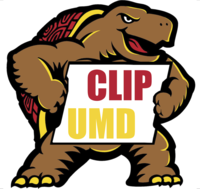Main Page: Difference between revisions
Computational Linguistics and Information Processing
No edit summary |
|||
| Line 15: | Line 15: | ||
|} | |} | ||
The group’s research covers most of the major areas of language research, including but not limited to speech recognition, handwriting and optical character recognition, multilingual text processing such as machine translation, and language data exploitation applications including [[Research#Summarization|document summarization]], sense-making across structured data such as ontologies and thesauri, information retrieval, ranking and personalization, and [[Research#Computational_Social_Science|computational social science]]. | We're located in AVW 3126. The group’s research covers most of the major areas of language research, including but not limited to speech recognition, handwriting and optical character recognition, multilingual text processing such as machine translation, and language data exploitation applications including [[Research#Summarization|document summarization]], sense-making across structured data such as ontologies and thesauri, information retrieval, ranking and personalization, and [[Research#Computational_Social_Science|computational social science]]. | ||
Natural language research focuses on several areas of broadscale multilingual processing, e.g., [[Research#Machine_Translation|machine translation]], [[Research#Summarization|summarization]], scalable translingual document detection, cross-language information retrieval, and computational social science. | Natural language research focuses on several areas of broadscale multilingual processing, e.g., [[Research#Machine_Translation|machine translation]], [[Research#Summarization|summarization]], scalable translingual document detection, cross-language information retrieval, and computational social science. | ||
Revision as of 19:18, 20 June 2014
Computational Linguistics and Information Processing at Maryland
The CLIP laboratory at Maryland is engaged in designing algorithms and building systems which allow computers to effectively and efficiently perform human language-related tasks and is part of the broader language science initiative at Maryland. The lab is a part of the University of Maryland Institute for Advanced Computer Studies (UMIACS), and is composed of faculty, researchers, and students spanning multiple departments:

We're located in AVW 3126. The group’s research covers most of the major areas of language research, including but not limited to speech recognition, handwriting and optical character recognition, multilingual text processing such as machine translation, and language data exploitation applications including document summarization, sense-making across structured data such as ontologies and thesauri, information retrieval, ranking and personalization, and computational social science.
Natural language research focuses on several areas of broadscale multilingual processing, e.g., machine translation, summarization, scalable translingual document detection, cross-language information retrieval, and computational social science.
Research in machine learning focuses on latent variable models of language, approximate inference, and how to make probabilistic models understandable to users.
Data management research focuses on architectures for wide area computation with heterogeneous information servers, pattern discovery from the annotated hyperlinked Web of life science resources, personalization and ranking and recommendation for social media, and event detection and monitoring.
Several language researchers in the CLIP lab are also affiliated with the Language and Media Processing (LAMP) Laboratory.